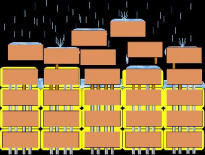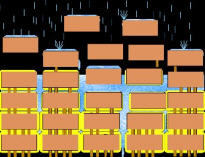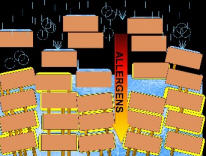Tiny cracks in skin barrier key to developing eczema
Groundbreaking international report supersedes established medical opinion
New evidence suggests that a defective skin barrier is the primary cause of eczema, not the immune system, as previously thought.
This is the breakthrough finding of an international report published in the Journal of Allergy and Clinical Immunology, highlighting the pivotal role of the skin barrier in eczema and the effects of genes and the environment on skin barrier breakdown.1
According to leading dermatologist, Dr John Su, Royal Children's Hospital, Melbourne, this new evidence was gleaned from global studies on atopic dermatitis (AD) showing that, in its mild to moderate form, the skin disease is probably triggered by something other than an allergic reaction to allergens.
"Until now, we believed most people with eczema were having an immune reaction to some external influence. However, this new report showed that up to 66 per cent of children with mild to moderate eczema did not actually have raised allergic antibodies," said Dr Su.
"Rather, a key factor in developing eczema is the structure of the skin barrier and the integrity of the cells' lipids and binders.
"So we now believe that tiny cracks in the skin barrier predispose some people to eczema," Dr Su said.
The skin barrier is the outer-most layer of the skin and is the first line of defence between the body and the environment1. Changes in skin barrier function affect the penetration of irritants and allergens through the skin2.
Genes that control the skin barrier are the major cause of altered skin barrier function1. Defective genes can affect normal functions of the skin, such as shedding of dead skin and replacement with new skin, by breaking binders between skin cells much faster than they are supposed to, resulting in thinning of the skin barrier1.
"People prone to eczema have a much thinner skin barrier than people with normal skin and this can be seen under a microscope, even if they do not have obvious eczema lesions," said Dr Su.
With normal skin, the skin barrier is thick and breakdown of the skin cell binders occurs only at the skin surface2. In skin prone to eczema, the binders are broken down all the way through the skin cell barrier2.
"The skin is structured like a brick wall, with cells and lipids and binders between the cells, similar to bricks and mortar and stabilising iron rods," Dr Su said.
"Rusted iron rods and gaps in the mortar cause the wall to break down and this is exactly what happens to the skin barrier of people prone to eczema."
While a thin skin barrier makes people more susceptible to developing eczema, flares or lesions often first occur following the use of irritants such as soap1.
Genetic predisposition to skin barrier breakdown combined with exposure to environmental irritants significantly increases the chance of eczema flares1.
"Soaps and detergents change skin pH and bind skin lipids. This results in further binder breakdown and removal of lipids which hold skin cells together, causing increasing breakdown in the skin barrier," Dr Su said.
Once a flare has been triggered by outside sources, inflamed cells produce a second lot of degrading substances which compound the breakdown of the skin barrier1.
At this stage, a very weakened skin barrier is susceptible to invading foreign bodies such as dust mites and golden staph bacteria (Staphylococcus aureus).
"In most instances, the entry of foreign bodies such as infective germs or allergens will cause an immune reaction in a person, resulting in an allergic inflammation," said Dr Su.
"The eczema flare or inflammation in this case however is triggered by breakdown proteins released by the micro-organisms themselves. In effect, this is a third breakdown in the skin barrier which leads to a severe eczema flare.
"This is known as the gene-environment interaction, where genetic predisposition compounded by external influences causes sore, weeping and inflamed eczema lesions," Dr Su said.
According to the breakthrough findings, controlling the external influences that come into contact with the skin is essential for reducing the damage to the skin barrier and the number of eczema flares1.
This includes following a strict diet regimen, avoiding activities, allergens and irritants which may trigger flares, replacing all soaps and detergents with emollients and avoiding prolonged use of potent steroid creams which also cause thinning of the skin barrier1.
"Steroid creams are important in controlling inflammation but their use should be limited to the few days when major flare or eruption is at its worst," said Dr Su.
"Long-term steroid use can lead to a vicious cycle whereby steroids increase skin barrier thinning, allowing ongoing allergen penetration which in turn increases inflammation and the need to re-use steroid creams and so on."
The new findings also confirm the importance of treating eczema much earlier in the cycle rather than waiting for a flare to occur1.
"Most people don't realise that they can prevent most of their severe flares by proactively treating them as soon as they begin," said Dr Su.
"Use of non-steroidal creams, which do not break down the skin barrier, at the first sign of symptoms, helps to control eczema.
"First signs of symptoms include a hint of itchiness, a spot or redness, the slightest bump or the tiniest tingle," said Dr Su.
The Eczema Control Plan, endorsed by the Eczema Association of Australasia Inc. (EAA), identifies and promotes understanding of the three stages of eczema - clear skin, first itch and redness and full flare.
President of the EAA and long-term eczema sufferer, Ms Cheryl Talent, explains: "The Eczema Control Plan has been designed to break the eczema cycle and help people to minimise the number of severe flares they experience by providing a treatment regimen tailored to the different stages of eczema.
"If followed correctly, this plan empowers people to control their eczema and reduce their eczema flares by half," Ms Talent said.
The Eczema Control Plan allows patients to follow a simple, three step treatment regimen as prescribed by their doctor and includes:
step 1 - use of a daily moisturiser when skin is clear
step 2 - use of non-steroidal creams to control eczema at the first signs of symptoms and just after a major flare
step 3 - use of steroid creams or ointments during a severe eczema flare.
"Understanding the skin barrier and how to protect it is a major step forward in controlling eczema and in improving the quality of life of those affected. Eczema is a serious skin disease which has been shown to be comparable to, or even worse than living with conditions such as insulin-dependent diabetes4," Ms Talent said.
The world's largest study (ISOLATE) of teenage patient perspectives on the management of atopic dermatitis3, has shown 75 per cent of carers and patients feel that being able to effectively control their eczema would be the single most important improvement to their own or their child's quality of life.

Skin cells (bricks) are held together by binders (iron rods) and lipids (mortar).

People with eczema also have gaps in their lipids or mortar.
This results in cracks all the way through the skin barrier.


Germs and more irritants then lead to an eczema flare.
New evidence suggests that a defective skin barrier is the primary cause of eczema, not the immune system, as previously thought.
This is the breakthrough finding of an international report published in the Journal of Allergy and Clinical Immunology, highlighting the pivotal role of the skin barrier in eczema and the effects of genes and the environment on skin barrier breakdown.1
According to leading dermatologist, Dr John Su, Royal Children's Hospital, Melbourne, this new evidence was gleaned from global studies on atopic dermatitis (AD) showing that, in its mild to moderate form, the skin disease is probably triggered by something other than an allergic reaction to allergens.
"Until now, we believed most people with eczema were having an immune reaction to some external influence. However, this new report showed that up to 66 per cent of children with mild to moderate eczema did not actually have raised allergic antibodies," said Dr Su.
"Rather, a key factor in developing eczema is the structure of the skin barrier and the integrity of the cells' lipids and binders.
"So we now believe that tiny cracks in the skin barrier predispose some people to eczema," Dr Su said.
The skin barrier is the outer-most layer of the skin and is the first line of defence between the body and the environment1. Changes in skin barrier function affect the penetration of irritants and allergens through the skin2.
Genes that control the skin barrier are the major cause of altered skin barrier function1. Defective genes can affect normal functions of the skin, such as shedding of dead skin and replacement with new skin, by breaking binders between skin cells much faster than they are supposed to, resulting in thinning of the skin barrier1.
"People prone to eczema have a much thinner skin barrier than people with normal skin and this can be seen under a microscope, even if they do not have obvious eczema lesions," said Dr Su.
With normal skin, the skin barrier is thick and breakdown of the skin cell binders occurs only at the skin surface2. In skin prone to eczema, the binders are broken down all the way through the skin cell barrier2.
"The skin is structured like a brick wall, with cells and lipids and binders between the cells, similar to bricks and mortar and stabilising iron rods," Dr Su said.
"Rusted iron rods and gaps in the mortar cause the wall to break down and this is exactly what happens to the skin barrier of people prone to eczema."
While a thin skin barrier makes people more susceptible to developing eczema, flares or lesions often first occur following the use of irritants such as soap1.
Genetic predisposition to skin barrier breakdown combined with exposure to environmental irritants significantly increases the chance of eczema flares1.
"Soaps and detergents change skin pH and bind skin lipids. This results in further binder breakdown and removal of lipids which hold skin cells together, causing increasing breakdown in the skin barrier," Dr Su said.
Once a flare has been triggered by outside sources, inflamed cells produce a second lot of degrading substances which compound the breakdown of the skin barrier1.
At this stage, a very weakened skin barrier is susceptible to invading foreign bodies such as dust mites and golden staph bacteria (Staphylococcus aureus).
"In most instances, the entry of foreign bodies such as infective germs or allergens will cause an immune reaction in a person, resulting in an allergic inflammation," said Dr Su.
"The eczema flare or inflammation in this case however is triggered by breakdown proteins released by the micro-organisms themselves. In effect, this is a third breakdown in the skin barrier which leads to a severe eczema flare.
"This is known as the gene-environment interaction, where genetic predisposition compounded by external influences causes sore, weeping and inflamed eczema lesions," Dr Su said.
According to the breakthrough findings, controlling the external influences that come into contact with the skin is essential for reducing the damage to the skin barrier and the number of eczema flares1.
This includes following a strict diet regimen, avoiding activities, allergens and irritants which may trigger flares, replacing all soaps and detergents with emollients and avoiding prolonged use of potent steroid creams which also cause thinning of the skin barrier1.
"Steroid creams are important in controlling inflammation but their use should be limited to the few days when major flare or eruption is at its worst," said Dr Su.
"Long-term steroid use can lead to a vicious cycle whereby steroids increase skin barrier thinning, allowing ongoing allergen penetration which in turn increases inflammation and the need to re-use steroid creams and so on."
The new findings also confirm the importance of treating eczema much earlier in the cycle rather than waiting for a flare to occur1.
"Most people don't realise that they can prevent most of their severe flares by proactively treating them as soon as they begin," said Dr Su.
"Use of non-steroidal creams, which do not break down the skin barrier, at the first sign of symptoms, helps to control eczema.
"First signs of symptoms include a hint of itchiness, a spot or redness, the slightest bump or the tiniest tingle," said Dr Su.
The Eczema Control Plan, endorsed by the Eczema Association of Australasia Inc. (EAA), identifies and promotes understanding of the three stages of eczema - clear skin, first itch and redness and full flare.
President of the EAA and long-term eczema sufferer, Ms Cheryl Talent, explains: "The Eczema Control Plan has been designed to break the eczema cycle and help people to minimise the number of severe flares they experience by providing a treatment regimen tailored to the different stages of eczema.
"If followed correctly, this plan empowers people to control their eczema and reduce their eczema flares by half," Ms Talent said.
The Eczema Control Plan allows patients to follow a simple, three step treatment regimen as prescribed by their doctor and includes:
"Understanding the skin barrier and how to protect it is a major step forward in controlling eczema and in improving the quality of life of those affected. Eczema is a serious skin disease which has been shown to be comparable to, or even worse than living with conditions such as insulin-dependent diabetes4," Ms Talent said.
The world's largest study (ISOLATE) of teenage patient perspectives on the management of atopic dermatitis3, has shown 75 per cent of carers and patients feel that being able to effectively control their eczema would be the single most important improvement to their own or their child's quality of life.

1: Normal skin
The very top layers of skin are cast off to let new skin come through.Skin cells (bricks) are held together by binders (iron rods) and lipids (mortar).

2: Skin prone to eczema
Faulty genes break down the skin barrier's binders or iron rods much faster than normal.People with eczema also have gaps in their lipids or mortar.
This results in cracks all the way through the skin barrier.

3: Soap and detergents
Irritants such as soap cause more break down and the "brick wall" starts to fall apart.
4: Dust mites and bacteria
A broken barrier lets allergens enter the skin easily.Germs and more irritants then lead to an eczema flare.
MORE
- Aussies Turning to Cyberspace to Self-Diagnose
- Waking up to the Dangers of Diabetes
- World Sight Day
- Your Cholesterol
- Go Ahead Take The Shot
- Do Brain Games Ward off Dementia?
- Complexity of Allergic Disease Impacts Patient...
- Carol Ireland and Renee Elliott Epilepsy Interview
- Bone Up on ways to Prevent Osteoporosis
- How Do You Stop Being Bullied Online?





